Editor of this issue: Antanas Klimas
Copyright © 1980 LITUANUS Foundation, Inc.

|
LITUANUS
LITHUANIAN QUARTERLY JOURNAL OF ARTS AND SCIENCES
Volume 26, No.2 - Summer 1980
Editor of this issue: Antanas Klimas ISSN 0024-5089
Copyright © 1980 LITUANUS Foundation, Inc. |

|
MUSIC IN THE SIXTEENTH CENTURY SOURCES OF MARTYNAS MAŽVYDAS
ENRIQUE ALBERTO ARIAS
American Conservatory
The Lithuanian Musicological Archives in Chicago has a copy of the facsimile edition of the liturgical publications of the Sixteenth century Lithuanian religious leader, Martynas Mažvydas (-1563). This facsimile was published in the city of Kaunas in 1922 under the direction of Dr. Jurgis Gerullis and contains Mažvydas four major undertakings: The Catechism (1547, p. 1) the Giesme S. Ambrasseijaus (1549, p. 80), the Forma Chrikstima (1559, p. 93), and the Gesmes Chriksczoniskas (1570, p. 149).1
It is known that the catechism was prepared while Mažvydas was a student at the University of Konigsberg and reflects his intense interest in the Reformation. His zeal resulted in his being invited to Lithuania Minor by the Prussian Duke Albert of Brandenburg where he vigorously proseletyzed for the cause of Protestantism.2
Dr. Gerullis notes in his introduction that Mažvydas was aided in his work by such authors as Stanislaus Rapaglenas, Augustinas Jamontas, and others, whose translations of such texts as the Pange Lingua and many psalms were incorporated in the sources mentioned above. Significant is the translation of a few Polish songs from Polish into Lithuanian by Janas Scheduikianis and Jonas Kyrtophoras. Clearly Mažvydas played the role of compilator and Protestant liturgical organizer, aided by writers of recognized ability.3
The facsimile comes to 592 pages and measures 4½ by 7 inches. In view of the type size and general spacing, I take these measurements to reflect the original.4 This copy was acquired by Prof. Žilevičius, the present director of the Archives, and was brought with him when he emigrated to the United States.5
The type style is sixteenth-century German Gothic and is both legible and well-spaced. Music is included throughout using a five-line staff and the white mensural notation of the Renaissance. The Ambrosian Te Deum is notated on a three-line staff, while both the Catechism and Cesses use a different type style from the subsequent publications. Staff lines are broken indicating that a double impression process was used in the printing.6 Obviously Mažvydas was either an accomplished musician himself or had recourse to someone else's expertise, since there is a full understanding of the notational techniques of the time.
Although the linguistic forms and literary content of these volumes have been analyzed, there has been heretofore no consideration of the music.7 There is hardly a page of these publications which does not have some sacred monody intended for a specific purpose. The Latin preface to the catechism by F. Staphylus, the Chancellor of the University of Konigsberg prepares the way for the Protestant Reformation. It speaks of the necessity of understanding simple Christian doctrine ("quae magis necessaria populo, quam doctrina coelestis") and of God's wish for all to be saved ("Deus vult omnes salvos fieri"). Furthermore, the preface continues, Lithuania is first in the world when it comes to ignorance about religion (. . . "quam praecaetris nationis Christianae") and, in a famous phrase, still worships idols ("alii arbores, alii flumina, alii serpentes, alii aliud colunt . . ."). What is implied is that these volumes were to be a means of converting Lithuania to Protestantism.8
Several aspects show this intent: they were printed at Konigsberg, a center of Protestant activity; they use the vernacular (i.e., Lithuanian) rather than Latin; and, most importantly, they contain hymn melodies which frequently have both the Latin and German title, or the German title alone, as in the case of the celebrated Ein Feste Burg (p. 394). Martin Luther's name is pointedly mentioned (pp. 372, 381, etc.). As we shall see, this approach is similar to that found in German sources of the late sixteenth-century.
The music is, with two exceptions, monodic.9 It falls into the following categories: Gregorian hymns with Lithuanian texts, Gregorian hymns used also by the Germans with Lithuanian texts (these have titles in both Lithuanian and German) and, finally, melodies with Lithuanian titles alone. In this regard the term Gregorian is broadly taken to include the Te Deum and several Ambrosian hymns.
As an instance of a melody derived from the Gregorian repertoire one can cite the Kyrie Paschale on pp. 246-248. The Gregorian Kyrie melody (LU, 16) is clearly the basis.10 The first phrase is used entirely, with the exception of a change of F to G for the third last note. This is no more a change than is to be found in countless Graduals of the sixteenth century. The melodic phrase for the Christe is two notes shorter than the version in the Liber. The final Ayr/EC, however, is one note longer than the accepted form. The text is a typical trope in that it speaks of God's power and glory. There is an alternation of breves and semibreves throughout, but without any implication of an exact relation between the two. It is my belief that Lithuanian monodies use longer rhythmic values to mark phrase endings and important articulations. Like many German melodies of the period, the rhythmic relations are imprecise.11
In several instances, such as the Antiphon Vena Sancte Spiritus (p.309) through the Introitus Spiritus Domini replevit orbed (p. 314), black rather than white mensural notation is utilized. There seems to be no distinction in performance implied in this shift. This is a practice found in other sources of the time, such as the Vesperarum precum officia published in Wittenberg in 1540 by Georg Rhau and the Danish Gradual, En Almindelig Sangbog (1573). Apparently this was a method of distinguishing repertory that was originally Gregorian.
The Forma orders its contents according to the season of the year. This was the usual Gregorian procedure, but eventually gave way to methods of organization based on the purpose of the text.
An example from the Gregorian Proper repertory is the Introitus de Sancte Sanitate (p. 321), which presents the melody found in LU, 909. Instead of an exact reduplication of the melody, there is much divergence, but within the original antiphonal structure. The incipit of ten notes is retained followed by a free adaptation of the general contours of the Gregorian antiphon through the text sawa on p. 323. This is followed by the Introit formula for the eighth mode, after which the incipit recurs. The principle operant here is the generally Protestant one of simplification and clarification.
Mažvydas uses the Gloria from the same Easter cycle on p. 402 (LU, 16), from which he chose a Kyrie melody, discussed previously. The opening phrase and the final melisma are kept, but the internal portion of the melody is freely varied. Comparing the Gregorian phrase Domine Deus to Agnus Dei, Filius Patris (p. 403, line 5 to p. 404, line 1) one sees a striking difference of detail, although the general shape is similar. (Ex. 1). The Gloria melodies of the Liber and the Mažvydas' sources are the same in length. The changes neither improve the line nor facilitate the setting of text. It is probable that Mažvydas was working from some German
source.12
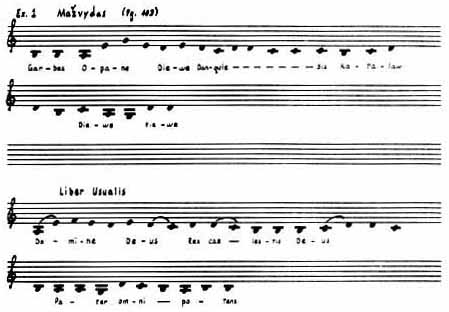
The Introitus Puer est natus (p. 209) is chosen from the Mass for Christmas Day (LU, 408). As in the Introitus de Sancta Sanitate, there is a systematic contraction of the Introit antiphon, before the attendant formula. Mažvydas' melody has 87 pitches as compared with the 107 pitches in the Liber. The compression results from the curtailment of each phrase inception. Even the opening G of the usual Introit formula for the seventh mode is deleted in Mažvydas' version.
A large number of Protestant hymn melodies are found throughout, which boldly proclaim the purpose of these publications. Included is the most famous of all German hymns, Ein Feste Burg on p. 394. Furthermore, it is given in the form with semibreve and minim rests at the outset, found as early as Klug's songbook of 1529. Thus Mažvydas retains the form as well as the contents of the German originals. The same kind of mensural notation used for Gregorian melodies is used for those of German origin and probably with the same general rather than specific rhythmic connotation.
In those instances where the German hymn has an earlier Gergorian model, Mažvydas systematically supplies both the Latin and German title, as in the favorite Pentecost sequence, Vena creator spiritus Kom got schopfer heyliger Geyst on p. 46. As is well known, this is one of the few Latin sequences from the vast number that appeared in the late Middle Ages that was retained by the Catholic church after the Counter-Reformation and one of the few also favored by the Protestants.12 Mažvydas' form of the melody of the first full line of Latin text differs appreciably from that given in LU, 885. (See Ex. 2) It is an obvious simplification, but maintains the essence of the original construct. The same text is given again on p. 312 with essentially the same melody.
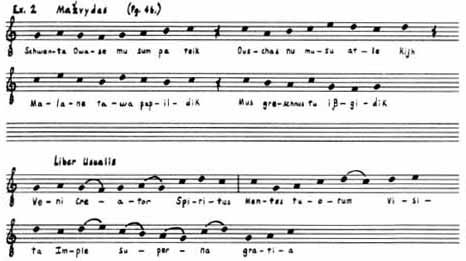
Other instances of melodies with double origin are the Ambrosian hymn, Vena redemptor gentium, which the Germans took over as Nu komm der Heiden Heiland (p. 152), and the Christe qui lux es et dies Christ der du bist tag und licht. The hymn melodies are all short, set syllabically and use melodies that can easily be remembered.13
There is a number of psalm-tone formulas for all the modes (pp. 484-488). Mažvydas has given nine (two are presented for the sixth mode). The gestic simplicity and elegance of these formulas were fully appreciated by the Protestants.
The most important group of melodies in these sources are those without Latin or German titles or any other indication of their origin. For the present purpose let us consider them to be original. There are some questions that naturally occur. Are these melodies of popular or folk origin? Do they differ from the other melodies in style? If, as we seen, these sources parallel German ones of the period, it is possible that Mažvydas, like Luther, was a composer. Reese and other authorities have pointed out that the style used in the creation of new hymns was close to the linear style generally favored in the Renaissance.14 There are two reasons for this: beginning with Luther, who was a passionate musician and gifted amateur composer, German Protestant reformers were educated in music and composed in a style redolent of the Renaissance masters; and secondly, universality of musical language was one way of achieving a "universal" gospel.
The Ponas musu on p. 141 has a total range of six notes from middle C to E below (sung once at the final cadence). Bb is the repeated or reciting tone, interrupted at times by two-note figures A-G, G-A and the like, which give variety and also create a larger sense of unity. The melody has the most flexible shape at the end, where the cadential G is reached after a graceful motion down to E.
Other melodies are simple songs with clearly symmetric structures, using a syllabic style. The Ponas te Passwelg on p. 146 is of this sort. This melody occurs three times in different rhythms, apparently to set the various texts with changing emphases. The shape is conjunct and close to a thousand turns of phrase one finds in the Gregorian repertory.
The Giesme raudinga on p. 425 is isorhythmic in structure. In such a melody I take the rhythm to have precise meaning. The opening ![]() is repeated at the beginnings of. the text phrases, forming a series of balanced units. The melody is incisive and energetic, and not unlike the melodic
patterns of the early sixteenth century chanson. (See Ex. 3)
is repeated at the beginnings of. the text phrases, forming a series of balanced units. The melody is incisive and energetic, and not unlike the melodic
patterns of the early sixteenth century chanson. (See Ex. 3)
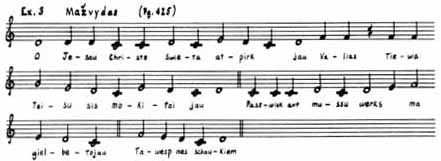
Both the Sena Gesme ape septinis on p. 445 and the Gesme nobazna on p. 450 are so like the chorale tunes of Mažvydas' German contemporaries that one suspects a borrowing. Both are isorhythmic and have the sharp profile one associates with the Germans. On the other hand, the short melodies for the Christus Diewas on p. 244 is imitative of the Gregorian line. (See Ex. 4) How different is the charming melody for Maria mergaite (p. 167) with its six short phrases, three of which open in similar fashion. The total structure is Rondo-like and looks to German formal practices.

Another instance of a structural reference to the Germans is the Bar form (AAB) of the Atlepimas on p. 272. The A phrase is comprised of a three-note motive punctuated by a rest, while the B phrase, beginning on the word smart's unfolds without pause. (See Ex. 5) Again the rhythmic notation must have significance, since the mensural distinctions highlight the structure. Similar is the Gesmes ant Dangunzegima pona on p. 308, which has the character of a folk song. It is not impossible that the Lithuanian folk song of this time, of which we know so little, may have been a source for a number of original melodies.
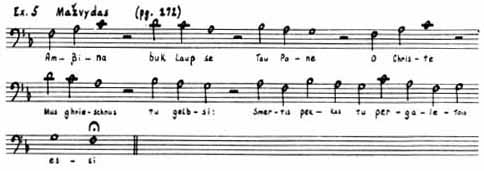
A few melodies are notated with the double rest at the beginning, similar to the Ein Feste Burg. Both the Christus wiens on p. 343 and the Pone Diewe on p. 409 open in this way and both are close in spirit to the German melodies.
The dactyllic pattern of ![]() is found in a group of melodies. One can cite a number which begin in this fashion, exemplified by the monodies on pp. 272, 425, 430 (See Ex. 6)
is found in a group of melodies. One can cite a number which begin in this fashion, exemplified by the monodies on pp. 272, 425, 430 (See Ex. 6)
Of interest is the setting of the Ten Commandments on p. 40. This melody is more elaborate than the two that were used by the Lutherans. As the melodic fragments go their way, they become increasingly disjunct, ending in a phrase for the Tenth Commandment which outlines a first-inversion triad.

Clearly the original melodies fall into three categories: formulaic phrases with varied reciting tones, melodies in the symmetric hymn style practiced by the Germans, and finally, melodies that are less clearly formed and are closer to the Gregorian style. The original melodies reflect the styles of the derived melodies. The inclusion of what seem original melodies fulfilled special liturgical needs not met by the older repertory.
Finally Mažvydas has included two polyphonic settings (pp. 269, 422). The first is a two-voiced treatment of the German Jesu Christ, unser Heiland with the chorale tune in the Discantus supported note-for-note by a lower voice. The other setting uses the Psalm, Beat; omnes qui timent Dominum in a simple homophonic style. Again the Discantus part is a lightly paraphrased version of a psalm-like formula with a simple homophonic support. The style of these pieces is competent without in the least being noteworthy, but their inclusion is important as being rare examples of Lithuanian polyphony. I give these two compositions in the appendix in modern transcription.
The historical and liturgical import of these sources has long been appreciated; but it is the music, derived from German sources and in the German style, which shows their intent. Whether Mažvydas was an original creator or a musical coordinator may be difficult to answer, but his sensitivity to music is everywhere manifest. In this regard he was the perfect disciple of Luther.
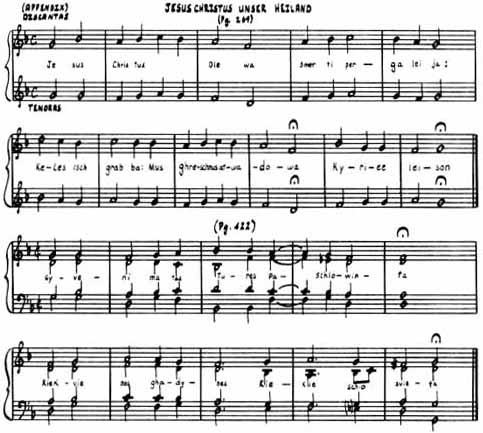
LISTING OF MUSIC
1 Pradestyse ... p. 40.
2 Nu bitten wir den heyligen geyst p. 43.
3 Vena creator spiritus Kom got schopfer heyliger Geyst p. 46.
4 Oratio Dominica Vater unser p. 48.
5 Nuhn lob meyn seel den herren p. 59.
6 Miserere mei Deus Erbarm dich mein her Gott p. 63.
7 Wir glauben all an einen Gott p. 68.
8 Dies est letitie Der tag der ist so freudenreich p. 72.
9 Jesus Christus unser heyland p. 75.
10 Christe qui lux es et dies p. 77.
11 1C/seme S. Ambrassejaus p. 82.
12 Christ unser herr zum Jordan kam p. 129.
13 Ponas musu Jesus Christus p. 141.
14 Ponas te passwelg p. 146.
15 Vena redemptor gentium Nu komm der heiden Heiland p. 152.
16 Ave Hierarchia coelestis et pia Menschen sind merkt eben p. 155.
17 Maria Mergaite p. 167.
18 Rorate caeli p. 171.
19 Conditor alme syderum p. 175.
20 A solis ortu cardine Christum wir sollen loben schon p. 177.
21 Von Himel hoch da kom ich her p. 183.
22 Dies est laethiciae Der tag der ist so freudenreich p. 189.
23 Puer natus in Bethlehem p. 194.
24 In dulci jubilo Nu singet und seid froh p. 198.
25 Nobis est natus hodie de pura Virgine p. 201.
26 In natali Domini gaudent omnes Angeli p. 203.
27 Introitus. Puer natus est nobis p. 209.
28 Kyrie fons bonitatis p. 213.
29 Gloria in excelsior Deo Allein Gott ihn der hoe sey ehre p. 215.
30 Grates nunc omnes p. 218.
31 Hostis Herodes impie Was furchstu seindt Herodes p. 222.
32 Mit fried und freud ich fahr dahin Nunc dimittis p. 225.
33 Christ unser Herr zum Jordan kam p. 231.
34 Benedictio Missae p. 239.
35 Christus Diewas p. 244.
36 Kyrie Paschale p. 246.
37 Vetus Cantio de Resurrectione Domini p. 250.
38 Christ ist erstanden p. 256.
39 Vita sanctorum Der heiligen Leben p. 258.
40 Hymnus: Ad coenam Agni providiDas Lemlein das zu Oster Zeit p. 261.
41 lesus Christus unser Heiland p. 269.
42 Singet wir heut mit gleichem mund p. 271.
43 Atlepimas p. 272.
44 Gelobet sei Gott im hochsten thron p. 275.
44 Schwenta esti labay p. 281.
45 Hym: Festum nunc celebre p. 283.
46 Antiphona. Wirai Galileas p. 285.
47 Gesmes ant Dangunzegima Pona p. 287.
48 Responsorium. Ite in orbed universum p. 293.
49 Introitus, wiari Galileas p. 298.
50 Alleluia p. 301.
51 Christ fuhr gen Himel p. 305.
52 Gesmes ant Dangunzegima Pona p. 308.
53 Vena sancte Spiritus p. 309.
54 Vena creator Spiritus Kom Gott schopfer heiliger Geist p. 312.
55 Introitus: Spiritus Domini repleuit orbed p. 314.
56 Halleluia p. 318.
57 Introitus de Sancta Sanitate p. 321.
58 Freud euch, Freud euch in dieser Zeit p. 328.
59 Nisi quia Dominus erat in nobis wo Gott der herr nicht bei uns helt p. 337.
60 De profundis Aus tieffer noth schrei ich p. 340.
61 Christus Wiens Sumus Diewa p. 343.
62 Deus misereatur nobis Es wolt Gott genedig sein p. 346.
63 Salvum me fac Ach Gott von Himmel sich darein p. 348.
64 Benedic anima mea Domino Nu lob mein Seel den Herren p. 352.
65 Miserere mei Deus Erbarm dich mein o Herre Gott p. 356.
66 Tas est Diewa prisakimas p. 360.
67 Nu bitten wir den Heiligen Geist p. 363.
68 Pange lingua gloriosi corporis Mein zung erkling und froh p. 369.
69 Jesus Christus unser Heiland p. 373.
70 Gott sey gelobet p. 377.
71 Pateris giesmen sugulditas p. 382.
72 Beati qui timent Dominum Wol dem der in Gottes furcht steht p. 386.
73 Da Pacem p. 390.
74 Ein feste burg ist unser Gott p. 394.
75 luste judex Jesu Christe p. 397.
76 Et in terra Paschale p. 402.
77 Ich dank dir fast p. 407.
78 Pone Diewe p. 409.
79 Nu last uns den leib begraben p. 413.
80 Beati omnes qui timent Dominum p. 422.
81 O Jesau Christe swieta p. 425.
82 Gesme ape schwenta Joba p. 430.
83 Patris sapientia, veritas Divina p. 441.
84 Ataminki žmogau p. 445.
85 Ischmintis Tiewa p. 450.
86 Psalmai ant Wakara p. 454.
87 Hymus, Christe qui lux es et dies Christe der du bist tag und licht p. 481.
88 Magnificat p. 484.
89 Benedicamus Dominicale p. 491.
90 Ant Welikas p. 492.
91 Peržegnoghima giesme p. 492.
92 Pradza iutrinas p. 502.
93 Antiphona služiket Ponui p. 503.
94 Psalmas Pirmas p. 504.
95 Benedictus p. 541.
96 Te Deum laudamus p. 545.
97 Media vita mitten wir im leben sind p. 564.
98 O Gott vater im Himmelreich p. 567.
99 Domine Rex Deus Abraham p. 575.
100 Auser a nobis Domine p. 577.
101 Contere Domine fortitudinem inimicorum p. 581.
1 I wish to thank Mme. Dalia Kučėnas for her assistance with the texts. For a discussion of the various dialects see: Alfonsas Šešplaukis, "The Martynas Mažvydas Catechism of 1547," Lituanus, XIX #3 (1973), 5.
2 Vincas Maciūnas, "Mažvydas," Encyclopedia Lituanica, ed. Simas Sužiedėlis and Vincas Rastenis (1973), Vol. Ill, 498.
3 Poland converted to Protestantism rather quickly. It was one of the major tasks of the Jesuit order to effect a
reconversion.
4 For a source of similar dimensions see the facsimile edition of the Peter Schoffer Liederbuch of 1513 (Berlin, 1908).
5 Interview with Prof. Žilevičius on June 21, 1979.
6 The style is similar to that used by the Italian printer Petrucci in his publication of the Odhecaton (1501).
7 Maciūnas, op. cit.
8 The classic study of music and music's role in the process of the Reformation is: Friedrich
Blume, Protestant Church Music A History (London: Victor Gollancz Ltd., 1975).
9 The early history of Protestant music is a history of its monody.
10 Liber Usualis (Tournai: Desclee, 1938). All references will be to this edition of the Liber and will use the abbreviation LU, followed by the page number of the chant.
11 Blume, op. cit., p. 66.
12 Work in this area is hampered by the unavailability of even facsimiles of German liturgical publications of the sixteenth century.
13 It must be remembered that such hymns as these or St. Thomas Aquinas' Pange Lingua were retained because of their popularity.
14 Gustave Reese, Music of the Renaissance (New York: W. W. Norton, 1959), p. 675.